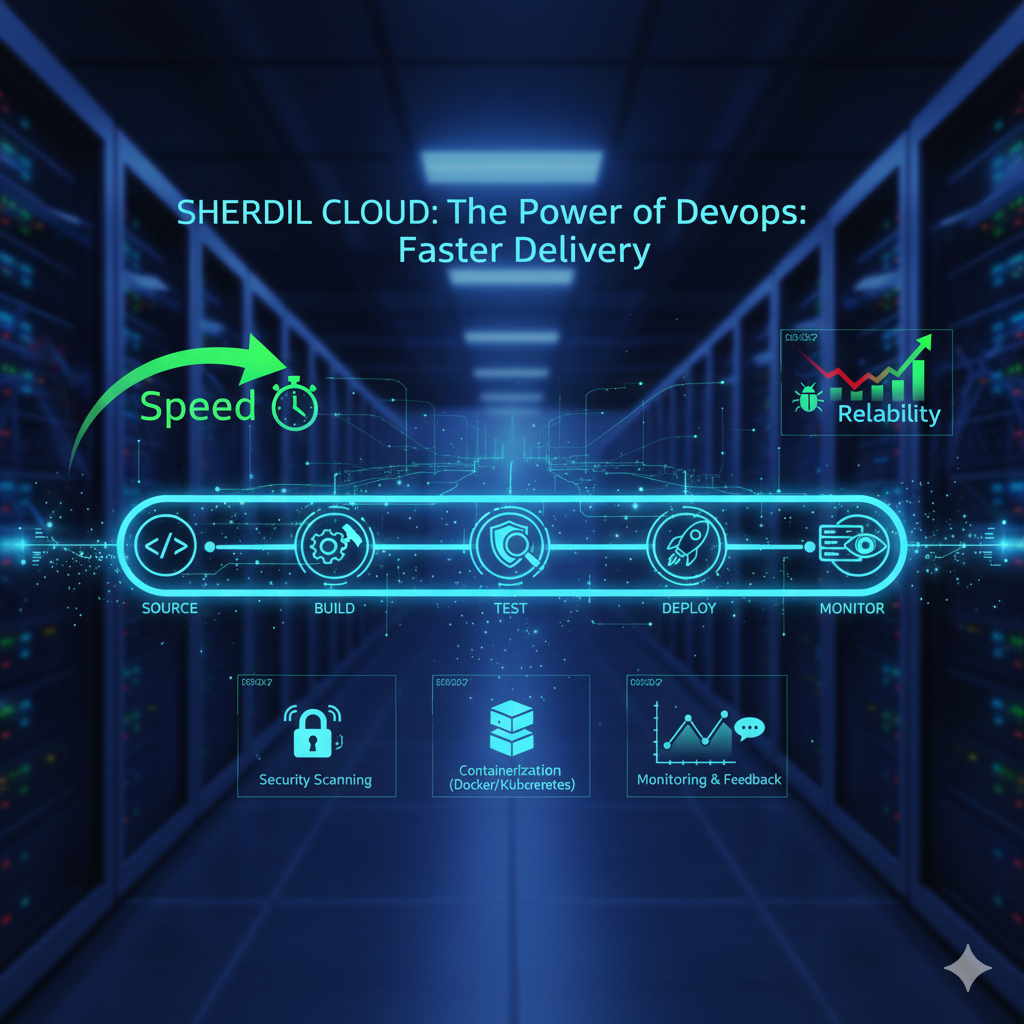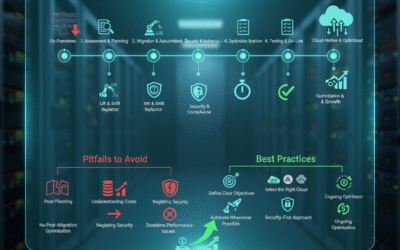
In the hyper-digital age of today, agility is no longer a luxury but a requirement. Organizations that can deliver products quicker and tweak to market requirements effortlessly are the ones that remain ahead. Behind such speed and dependability stands the core of software delivery in the modern times: CI/CD pipelines.
We at Sherdil Cloud enable organizations to adopt CI/CD as a fundamental DevOps practice to deliver high-quality software faster, safer, and smarter. But what is CI/CD, and why is it so highly sought after in modern times? Let’s demystify it.
What Is CI/CD?
CI/CD is short for Continuous Integration (CI) and Continuous Delivery (CD) or Continuous Deployment. It’s basically an automated process that moves code from development to production, integrating, testing, and delivering applications in a smooth, repeatable, and consistent way.
Continuous Integration (CI) refers to combining code changes regularly, preferably several times a day. Each change is automatically built, tested, and validated in order to identify problems early.
Continuous Delivery (CD) makes it so that code is always deployable, ready to be deployed at any given time.
Continuous Deployment takes delivery a step further and pushes tested code into production automatically without explicit approval.
Combined, these actions form a pipeline — an automated belt that turns ideas into deployable software quickly and safely.
Why CI/CD Matters
Legacy software releases were slow, buggy, and relying on manual interventions. On the other hand, CI/CD pipelines give:
-Speed: Automated testing and deployment significantly reduce development cycles.
-Reliability: Bug detection early on reduces production failures.
-Consistency: Each release uses the same process, eliminating human error.
-Security: Integrated quality checks and automated scanning enhance compliance and vulnerability management.
-Collaboration: CI/CD promotes collaboration by aligning developer, tester, and operations effort.
At Sherdil Cloud, we’ve seen organizations cut release times from weeks to hours, all while improving code quality and reducing downtime.
The Anatomy of a CI/CD Pipeline
An efficiently designed pipeline would normally comprise these phases:
1.Source Stage
Here, code changes are pushed by developers to a common repository (such as GitHub, GitLab, or Bitbucket). CI tools like Jenkins, GitHub Actions, or AWS CodePipeline scan for changes and initiate the pipeline.
2.Build Stage
The code is built, dependencies are resolved, and the application is packaged. Build issues are immediately indicated, so no broken code moves forward.
3.Test Stage
Automated tests, unit, integration, and performance tests are executed to ensure the new code does not break the current functionality.
4.Deploy Stage
After passing tests, the application is deployed to staging or production environments. It can be done manually (Continuous Delivery) or automatically (Continuous Deployment).
5.Monitor Stage
After deployment, monitoring tools monitor performance, errors, and user behavior. Feedback from this stage feeds back to developers for ongoing improvement.
Every phase creates a vital link, and automation maintains the chain intact and productive.
Tools That Power CI/CD
The CI/CD infrastructure is full of high-capacity tools, and at Sherdil Cloud, we create pipelines with the top combination for every client’s requirement. Well-known tools are:
Jenkins: The default open-source automation server.
GitLab CI/CD: A highly integrated DevOps lifecycle tool.
AWS CodePipeline: Best suited for cloud-native AWS ecosystems.
Azure DevOps: Smooth integration for Microsoft environments.
GitHub Actions: CI/CD right within your code repository.
ArgoCD & Spinnaker: For Kubernetes and containerized environments.
The choice of appropriate tools is subject to infrastructure, personnel expertise, and depth of automation desired, and that’s where Sherdil excels.
CI/CD and DevOps: The Perfect Partnership
CI/CD isn’t about automation, it’s the driving engine behind DevOps.
DevOps encourages joint collaboration of development and operations teams to eliminate silos and promote shared responsibility for delivery. CI/CD supports this by providing the discipline and automation required for DevOps.
In a Sherdil Cloud deployment, CI/CD pipelines form the foundation of operational effectiveness, delivering quicker innovation without risking stability or compliance.
Security in the CI/CD Lifecycle
Security is too often an afterthought in high-speed development teams, but it doesn’t have to be. Pipelines today weave in DevSecOps, with security built in from the beginning.
Sherdil Cloud makes use of:
-Static Application Security Testing (SAST) to scan code for weaknesses.
-Dynamic Application Security Testing (DAST) to mimic actual attacks.
-Dependency Scanning to identify old or dangerous libraries.
-Secrets Management to safeguard sensitive credentials.
In this manner, security is woven into the fabric of the process, rather than a barrier to progress.
Cloud-Native CI/CD: Scaling for Modern Applications
With cloud computing and microservices on the rise, CI/CD has adapted to support sophisticated architectures. Cloud-native pipelines use containerization (with Docker) and orchestration (with Kubernetes) to automate multi-environment deployments.
Sherdil Cloud enables organizations to introduce cloud-native CI/CD pipelines that are:
-Scalable: Support large workloads on AWS, Azure, and Google Cloud.
-Resilient: Designed for disaster recovery and fault tolerance.
-Observable: End-to-end monitored for performance information.
For example, we’ve helped enterprises reduce downtime by implementing blue-green deployments and canary releases, deployment strategies that minimize risk while delivering continuous innovation.
Common CI/CD Challenges (and How We Solve Them)
Even the best pipelines face challenges, but with the right expertise, they can be overcome:
| Challenge | Sherdil Cloud Solution |
|---|---|
| Slow build times | Optimize build caching and parallel testing |
| Environment inconsistencies | Use Infrastructure as Code (IaC) tools like Terraform |
| Security concerns | Integrate automated vulnerability scans |
| Manual approvals blocking automation | Implement progressive delivery with policy-based controls |
| Lack of visibility | Enable real-time dashboards and centralized monitoring |
Our focus is always on creating resilient pipelines that deliver real business value, not just technical efficiency.
Real-World Impact: Faster Releases, Happier Teams
A fintech customer came to Sherdil Cloud in distress from extended release cycles and constant post-deployment problems. By deploying a strong CI/CD pipeline of Jenkins, Docker, and AWS CodePipeline, they were able to experience:
-60% reduced deployment times
-45% less production bugs
-Enhanced inter-team collaboration
-Through automated repeating work and continuous feedback integration, the team regained precious time for innovation, while the business experienced quicker time-to-market and increased customer satisfaction.
Looking Ahead: The Future of CI/CD
The future of CI/CD is autonomous delivery, learning and evolving pipelines that leverage AI and analytics to optimize themselves. Sherdil Cloud is already assisting customers in progressing towards:
-Predictive Build Optimization with AI.
-Intelligent Test Automation for more intelligent QA cycles.
-Self-Healing Pipelines that correct most common errors automatically.
As companies move further towards DevOps maturity, CI/CD will continue to be the backbone of innovation, where automation, intelligence, and agility come together in harmonious balance.


